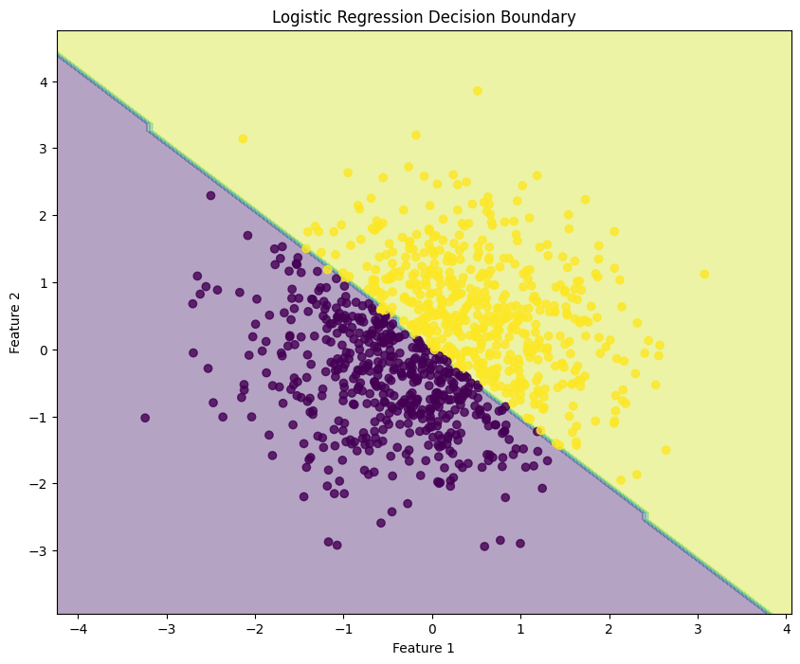分類是機器學習和資料科學中使用的一種監督學習技術,用於將資料分類為預先定義的類別或標籤。它涉及訓練一個模型,根據輸入資料點的特徵將其分配給幾個離散類別之一。分類的主要目的是準確預測新的、未見過的資料點的類別。
1。二元分類
2。多類分類
線性分類器是一類分類演算法,它使用線性決策邊界來分離特徵空間中的不同類別。他們透過線性方程式組合輸入特徵來進行預測,通常表示特徵和目標類標籤之間的關係。線性分類器的主要目的是透過找到將特徵空間劃分為不同類別的超平面來有效地將資料點分類。
邏輯迴歸是一種用於機器學習和資料科學中二元分類任務的統計方法。它是線性分類器的一部分,與線性迴歸不同,它透過將資料擬合到邏輯曲線來預測事件發生的機率。
1。 Logistic 函數(S 型函數)
2。邏輯迴歸方程式
MLE 用於透過最大化觀察給定模型的資料的可能性來估計邏輯迴歸模型的參數(係數)。
方程式:最大化對數似然函數涉及找到最大化觀察資料的機率的參數。
邏輯迴歸中的成本函數衡量預測機率與實際類別標籤之間的差異。目標是最小化此函數以提高模型的預測準確性。
對數損失(二元交叉熵):
對數損失函數常用於二元分類任務的邏輯迴歸。
對數損失 = -(1/n) * Σ [y * log(ŷ) + (1 - y) * log(1 - ŷ)]
地點:
對數損失會懲罰遠離實際類別標籤的預測,從而鼓勵模型產生準確的機率。
損失最小化涉及找到最小化成本函數值的模型參數值。此過程也稱為最佳化。邏輯迴歸中損失最小化最常用的方法是梯度下降演算法。
梯度下降是一種迭代最佳化演算法,用於最小化邏輯迴歸中的成本函數。它沿著成本函數最速下降的方向調整模型參數。
梯度下降的步驟:
初始化參數:從模型參數的初始值開始(例如係數 w0、w1、...、wn)。
計算梯度:計算成本函數相對於每個參數的梯度。梯度是成本函數的偏導數。
更新參數:向漸變的反方向調整參數。調整由學習率 (α) 控制,它決定了向最小值邁出的步長。
重複:迭代這個過程,直到成本函數收斂到最小值(或達到預先定義的迭代次數)。
參數更新規則:
對於每個參數 wj:
wj = wj - α * (∂/∂wj) 對數損失
地點:
對數損失關於 wj 的偏導數可以計算為:
(∂/∂wj) 對數損失 = -(1/n) * Σ [ (yi - ŷi) * xij / (ŷi * (1 - ŷi)) ]
地點:
邏輯迴歸是一種用於二元分類任務的技術,對給定輸入屬於特定類別的機率進行建模。此範例示範如何使用合成資料實現邏輯迴歸、評估模型的效能以及視覺化決策邊界。
1。導入庫
import numpy as np import matplotlib.pyplot as plt from sklearn.model_selection import train_test_split from sklearn.linear_model import LogisticRegression from sklearn.metrics import accuracy_score, confusion_matrix, classification_report
此區塊導入資料操作、繪圖和機器學習所需的庫。
2。產生樣本資料
np.random.seed(42) # For reproducibility X = np.random.randn(1000, 2) y = (X[:, 0] + X[:, 1] > 0).astype(int)
此區塊產生具有兩個特徵的樣本數據,其中根據特徵總和是否大於零來定義目標變數 y,模擬二元分類場景。
3。分割資料集
X_train, X_test, y_train, y_test = train_test_split(X, y, test_size=0.2, random_state=42)
此區塊將資料集拆分為訓練集和測試集以進行模型評估。
4。建立並訓練邏輯迴歸模型
model = LogisticRegression(random_state=42) model.fit(X_train, y_train)
此區塊初始化邏輯迴歸模型並使用訓練資料集進行訓練。
5。做出預測
y_pred = model.predict(X_test)
此區塊使用經過訓練的模型對測試集進行預測。
6。評估模型
accuracy = accuracy_score(y_test, y_pred)
conf_matrix = confusion_matrix(y_test, y_pred)
class_report = classification_report(y_test, y_pred)
print(f"Accuracy: {accuracy:.4f}")
print("\nConfusion Matrix:")
print(conf_matrix)
print("\nClassification Report:")
print(class_report)
輸出:
Accuracy: 0.9950
Confusion Matrix:
[[ 92 0]
[ 1 107]]
Classification Report:
precision recall f1-score support
0 0.99 1.00 0.99 92
1 1.00 0.99 1.00 108
accuracy 0.99 200
macro avg 0.99 1.00 0.99 200
weighted avg 1.00 0.99 1.00 200
此區塊計算並列印準確性、混淆矩陣和分類報告,提供對模型效能的深入了解。
7。可視化決策邊界
x_min, x_max = X[:, 0].min() - 1, X[:, 0].max() + 1
y_min, y_max = X[:, 1].min() - 1, X[:, 1].max() + 1
xx, yy = np.meshgrid(np.arange(x_min, x_max, 0.1),
np.arange(y_min, y_max, 0.1))
Z = model.predict(np.c_[xx.ravel(), yy.ravel()])
Z = Z.reshape(xx.shape)
plt.figure(figsize=(10, 8))
plt.contourf(xx, yy, Z, alpha=0.4)
plt.scatter(X[:, 0], X[:, 1], c=y, alpha=0.8)
plt.xlabel("Feature 1")
plt.ylabel("Feature 2")
plt.title("Logistic Regression Decision Boundary")
plt.show()
此區塊視覺化邏輯迴歸模型所建立的決策邊界,說明模型如何在特徵空間中分離兩個類別。
輸出:

這種結構化方法展示瞭如何實現和評估邏輯回歸,讓人們清楚地了解其二元分類任務的功能。決策邊界的可視化有助於解釋模型的預測。
Logistic regression can also be applied to multiclass classification tasks. This example demonstrates how to implement logistic regression using synthetic data, evaluate the model's performance, and visualize the decision boundary for three classes.
1. Import Libraries
import numpy as np import matplotlib.pyplot as plt from sklearn.model_selection import train_test_split from sklearn.linear_model import LogisticRegression from sklearn.metrics import accuracy_score, confusion_matrix, classification_report
This block imports the necessary libraries for data manipulation, plotting, and machine learning.
2. Generate Sample Data with 3 Classes
np.random.seed(42) # For reproducibility
n_samples = 999 # Total number of samples
n_samples_per_class = 333 # Ensure this is exactly n_samples // 3
# Class 0: Top-left corner
X0 = np.random.randn(n_samples_per_class, 2) * 0.5 + [-2, 2]
# Class 1: Top-right corner
X1 = np.random.randn(n_samples_per_class, 2) * 0.5 + [2, 2]
# Class 2: Bottom center
X2 = np.random.randn(n_samples_per_class, 2) * 0.5 + [0, -2]
# Combine the data
X = np.vstack([X0, X1, X2])
y = np.hstack([np.zeros(n_samples_per_class),
np.ones(n_samples_per_class),
np.full(n_samples_per_class, 2)])
# Shuffle the dataset
shuffle_idx = np.random.permutation(n_samples)
X, y = X[shuffle_idx], y[shuffle_idx]
This block generates synthetic data for three classes located in different regions of the feature space.
3. Split the Dataset
X_train, X_test, y_train, y_test = train_test_split(X, y, test_size=0.2, random_state=42)
This block splits the dataset into training and testing sets for model evaluation.
4. Create and Train the Logistic Regression Model
model = LogisticRegression(random_state=42) model.fit(X_train, y_train)
This block initializes the logistic regression model and trains it using the training dataset.
5. Make Predictions
y_pred = model.predict(X_test)
This block uses the trained model to make predictions on the test set.
6. Evaluate the Model
accuracy = accuracy_score(y_test, y_pred)
conf_matrix = confusion_matrix(y_test, y_pred)
class_report = classification_report(y_test, y_pred)
print(f"Accuracy: {accuracy:.4f}")
print("\nConfusion Matrix:")
print(conf_matrix)
print("\nClassification Report:")
print(class_report)
Output:
Accuracy: 1.0000
Confusion Matrix:
[[54 0 0]
[ 0 65 0]
[ 0 0 81]]
Classification Report:
precision recall f1-score support
0.0 1.00 1.00 1.00 54
1.0 1.00 1.00 1.00 65
2.0 1.00 1.00 1.00 81
accuracy 1.00 200
macro avg 1.00 1.00 1.00 200
weighted avg 1.00 1.00 1.00 200
This block calculates and prints the accuracy, confusion matrix, and classification report, providing insights into the model's performance.
7. Visualize the Decision Boundary
x_min, x_max = X[:, 0].min() - 1, X[:, 0].max() + 1
y_min, y_max = X[:, 1].min() - 1, X[:, 1].max() + 1
xx, yy = np.meshgrid(np.arange(x_min, x_max, 0.1),
np.arange(y_min, y_max, 0.1))
Z = model.predict(np.c_[xx.ravel(), yy.ravel()])
Z = Z.reshape(xx.shape)
plt.figure(figsize=(10, 8))
plt.contourf(xx, yy, Z, alpha=0.4, cmap='RdYlBu')
scatter = plt.scatter(X[:, 0], X[:, 1], c=y, cmap='RdYlBu', edgecolor='black')
plt.xlabel("Feature 1")
plt.ylabel("Feature 2")
plt.title("Multiclass Logistic Regression Decision Boundary")
plt.colorbar(scatter)
plt.show()
This block visualizes the decision boundaries created by the logistic regression model, illustrating how the model separates the three classes in the feature space.
Output:

This structured approach demonstrates how to implement and evaluate logistic regression for multiclass classification tasks, providing a clear understanding of its capabilities and the effectiveness of visualizing decision boundaries.
Evaluating a logistic regression model involves assessing its performance in predicting binary or multiclass outcomes. Below are key methods for evaluation:
from sklearn.metrics import accuracy_score
accuracy = accuracy_score(y_test, y_pred)
print(f'Accuracy: {accuracy:.4f}')
from sklearn.metrics import confusion_matrix
conf_matrix = confusion_matrix(y_test, y_pred)
print("\nConfusion Matrix:")
print(conf_matrix)
from sklearn.metrics import precision_score
precision = precision_score(y_test, y_pred, average='weighted')
print(f'Precision: {precision:.4f}')
from sklearn.metrics import recall_score
recall = recall_score(y_test, y_pred, average='weighted')
print(f'Recall: {recall:.4f}')
from sklearn.metrics import f1_score
f1 = f1_score(y_test, y_pred, average='weighted')
print(f'F1 Score: {f1:.4f}')
Cross-validation techniques provide a more reliable evaluation of model performance by assessing it across different subsets of the dataset.
from sklearn.model_selection import KFold, cross_val_score
kf = KFold(n_splits=5, shuffle=True, random_state=42)
scores = cross_val_score(model, X, y, cv=kf, scoring='accuracy')
print(f'Cross-Validation Accuracy: {np.mean(scores):.4f}')
from sklearn.model_selection import StratifiedKFold
skf = StratifiedKFold(n_splits=5)
scores = cross_val_score(model, X, y, cv=skf, scoring='accuracy')
print(f'Stratified K-Fold Cross-Validation Accuracy: {np.mean(scores):.4f}')
By utilizing these evaluation methods and cross-validation techniques, practitioners can gain insights into the effectiveness of their logistic regression model and its ability to generalize to unseen data.
Regularization helps mitigate overfitting in logistic regression by adding a penalty term to the loss function, encouraging simpler models. The two primary forms of regularization in logistic regression are L1 regularization (Lasso) and L2 regularization (Ridge).
概念:L2正則化在損失函數中加入等於係數大小平方的懲罰。
損失函數:嶺邏輯迴歸的修正損失函數表示為:
損失 = -Σ[yi * log(ŷi) + (1 - yi) * log(1 - ŷi)] + λ * Σ(wj^2)
地點:
效果:
概念:L1正則化在損失函數中加入等於係數振幅絕對值的懲罰。
損失函數:Lasso邏輯迴歸的修改損失函數可以表示為:
損失 = -Σ[yi * log(ŷi) + (1 - yi) * log(1 - ŷi)] + λ * Σ|wj|
地點:
效果:
透過在邏輯迴歸中應用正規化技術,從業者可以增強模型泛化並有效管理偏差-變異數權衡。
以上是邏輯迴歸,分類:監督機器學習的詳細內容。更多資訊請關注PHP中文網其他相關文章!




